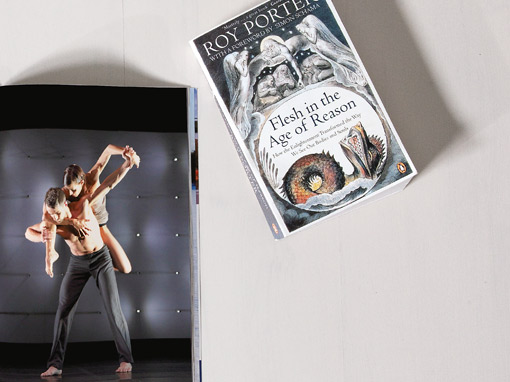
FAR
A dance depiction of the age of enlightenment. Choreographer Wayne McGregor found his inspiration for F.A.R. in Ray Porter’s book Flesh in the Age of Reason, a story about an 18th century journey of enlightenment in body and soul. Ten amazing dancers challenge the distortions, sensuality and feeling of an age permeated by the search for knowledge. Accompanied by an insistent, contemporary music score by Ben Frost.This is the first visit to Norway by the Wayne McGregor | Random Dance company. Besides being the company where Wayne McGregor has developed his strong choreographic signature, Random Dance is known for steadily pushing the boundaries of dance and incorporating new technology and other forms of artistic expression into performances.
Wayne McGregor is house choreographer with the Royal Ballet in London and currently one of the most in-demand choreographers. He has also studied experimental psychology at Cambridge University and several of his works are the result of research processes in psychology. So it is with F.A.R. According to the New York Times, he creates “Some of the most exciting work in ballet on the planet”.
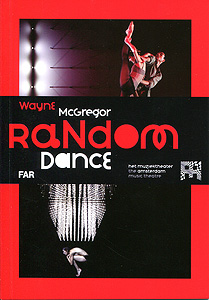
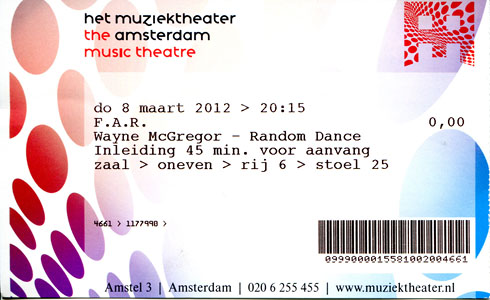 Concept, Direction & Choreography: Wayne McGregor
Concept, Direction & Choreography: Wayne McGregorMusic: Ben Frost
Costume Design: Moritz Junge
Set Design: rAndom International
Lighting Design: Lucy Carter
Cast:10 dancers
Duration: 60 minutes
Since its premiere in 2010 FAR has toured the world, picking up accolades for McGregor's ever-insightful vision, performed by ten dancers from Wayne McGregor | Random Dance. A superb score by Brian Eno collaborator Ben Frost and jaw-dropping visuals including a computerized pin board of 3,200 LED lights, make this an absolute must-see.
With FAR, McGregor takes a fascinating creative journey, drawing on a radical cognitive research process. Inspired by the controversial Age of Enlightenment and by the 18th century French philosopher Diderot's very first set of encyclopaedia, the resulting choreography is both physical and immediate, yet intensely cerebral.
Made possible in part by a grant from the Association of Performing Arts Presenters Creative Campus Innovations Grant Program, funded by the Doris Duke Charitable Foundation.
Co-Commissioned by: Maison de la Danse, Lyon, FR; Fondazione I Teatri, Reggio Emilia, IT; Belgrade Dance Festival, Belgrade, SE; Belfast Festival, Belfast, UK; Brighton Dome, Brighton, UK; Laban Theatre, London, UK and DanceEast, Ipswich, UK

Texts
“In flesh and blood lay the self and its articulations. With its own elaborate sign language of gesture and feeling, the body was the inseparable dancing partner of the mind or soul; now in step, now a tangle of limbs and intentions, mixed emotions. Organism and consciousness, soma and psyche, heart and head, the outer and the inner_all merged, and all needed to be minutely observed if the human enigma were ever to be appreciated."– Roy Porter, Flesh in the Age of Reason
Inspired by the controversial Age of Enlightenment, FAR mines an era that first placed ‘a body in question’. Ten incredible dancers confront the distortions, sensuality and feeling of the 18th Century’s searing contemporary sensibility to a new, haunting score by the critically-acclaimed composer Ben Frost.
Press
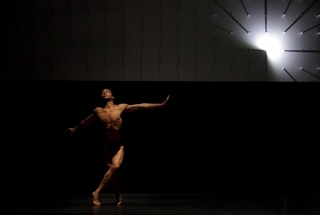 The New Yorker, October 31 2011
The New Yorker, October 31 2011"The choreography is high-speed and relentless, the lighting designs dazzling, and the bodies sinuous and endlessly torqued. If it’s not William Forsythe, it must be Wayne McGregor, the boy genius of English dance."
The Observer, November 21 2010
"There's the sensually complex work on stage to engage with, and there is the equally demanding task of following the choreographer's intellectual trail. The style is clearly McGregor's own_the rippling backs, the tendril arms, the probing hyperextensions_... this is McGregor in evolution." A new McGregor piece is always a challenge. There's the sensually complex work on stage to engage with, and there is the equally demanding task of following the choreographer's intellectual trail. FAR is an abbreviation of Flesh in the Age of Reason, the title of the late Roy Porter's exploration of 18th-century thought concerning the relationship of mind and body. To a Ben Frost score, which proceeds from sampled Vivaldi to a bestial electronic growl, the 10 performers engage in a series of cryptic, intense encounters.
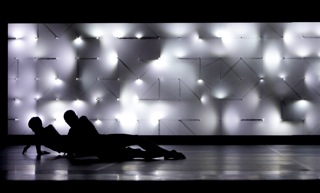 The style is clearly McGregor's own – the rippling backs, the tendril arms,
the probing hyperextensions – but this is McGregor in evolution. Gone, for
now, are the neurotic deformations of line; in their place is a blazing,
mysterious post-classicism, perhaps most potently embodied by Alexander
Whitley, newly returned from Sydney Dance Company. The lighting design is
by Lucy Carter, who has placed a winking pinpoint array behind the dancers,
its elegant mutations suggesting star-fields and neural pathways. There
is, as so often with McGregor, the sense of the atomised individual striving
for connection, for a place in the universe.
The style is clearly McGregor's own – the rippling backs, the tendril arms,
the probing hyperextensions – but this is McGregor in evolution. Gone, for
now, are the neurotic deformations of line; in their place is a blazing,
mysterious post-classicism, perhaps most potently embodied by Alexander
Whitley, newly returned from Sydney Dance Company. The lighting design is
by Lucy Carter, who has placed a winking pinpoint array behind the dancers,
its elegant mutations suggesting star-fields and neural pathways. There
is, as so often with McGregor, the sense of the atomised individual striving
for connection, for a place in the universe.Should we connect this to Enlightenment thought? To Descartes's cogito ergo sum, and the journey, post-Locke, to a conscious selfhood? It's possible, but go too far in that direction and you lose sight of the dance. It's a subjective thing, but what I find works well with McGregor's choreography is to allow its cerebral aspects to colour it like a faint, transparent tincture. Muse too intently on notions of embodiment and you stop seeing the living bodies in front of you. They're the story, ultimately.
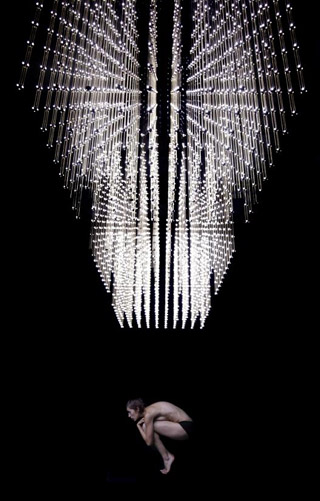 The Independent, November 21 2010
The Independent, November 21 2010"...[T]he opening duet is one of the most purely beautiful things McGregor has made...[F]or all its animalism...it glimmers with humanity."
For a man who's regularly called a boffin and a cybergeek, it must feel good to prove you have a beating heart.
The opening minutes of Wayne McGregor's latest creation with his rubber-limbed group, Random, is as close to soft-focus intimacy as you're likely to get from Britain's edgiest, most prolific, most ambitious choreographer. Not for nothing is one of his earlier works, Entity, about to be downloadable to an iPod – not just a first for contemporary dance, but for dance of any kind.
Wayne McGregor Random (he insists on that formulation, to give his dancers their collaborative due) have not always thrilled me. I am sceptical of the experiments in cognitive science that McGregor claims underpin the work – not doubting the science, as such, but its applicability to performance destined for a theatre stage. Every artist has their process, their means of breaking free of creative habit. How she or he arrives at this is immaterial to the end result.
I am also wary of danceworks that require pages of programme notes to make sense of them. So it was that I watched FAR with a blissfully open mind. Oblivious to the choreographer's explanation that FAR stands for "Flesh in the Age of Reason", the title of a recent book on 18th-century explorations into the nature of the body and notions of the soul, I decided it referred to the far-off continent of Africa, where McGregor spends some of his time. All the nuzzling, prowling, stalking, snaking, shivering and slithering features of the dancers' movements made perfect sense in terms of African wildlife. And this was confirmed, for me, by Ben Frost's engrossing musical score, with its snufflings, grunts and squawks seamlessly embedded in the electronically generated material.
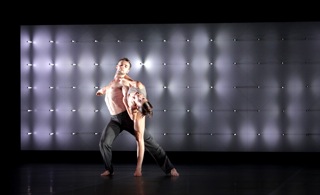 So much for the creator's intentions. But does it matter that a person's
reading of a work is so off-beam? More important is whether it holds us
rapt for its full duration. And, for the first time in a work McGregor has
made with Random, FAR grabs your attention and doesn't let go. The sheer
novelty of the slicing angles and whiplash curves that flicker through the
dancers' limbs and torsos has always been dazzling – for the first 15 minutes.
FAR, though, sustains and follows through. And for all that it lasts no
more than an hour, it feels substantial. The drama of rAndom International's
set design (some relation, surely?) – a pinboard of tiny white lights that
signals extremes of weather, from blizzard to clear night sky – is an ever-changing
marvel.
So much for the creator's intentions. But does it matter that a person's
reading of a work is so off-beam? More important is whether it holds us
rapt for its full duration. And, for the first time in a work McGregor has
made with Random, FAR grabs your attention and doesn't let go. The sheer
novelty of the slicing angles and whiplash curves that flicker through the
dancers' limbs and torsos has always been dazzling – for the first 15 minutes.
FAR, though, sustains and follows through. And for all that it lasts no
more than an hour, it feels substantial. The drama of rAndom International's
set design (some relation, surely?) – a pinboard of tiny white lights that
signals extremes of weather, from blizzard to clear night sky – is an ever-changing
marvel.Lit by flaming torches, one at each corner of the stage, held by a sentinel dancer and casting flickering golden shadows on bare skin, the opening duet is one of the most purely beautiful things McGregor has made. The intimate pianissimo control of the singing of Cecilia Bartoli – recorded Vivaldi – adds its own layer of gorgeousness, to the extent that you almost decline to breathe, for fear of breaking its spell.
 There is rigour, too, in FAR.
And whiplash speed, and plenty of Mr McG's trademark distortion of limbs.
Yet for all its animalism (and, dammit, that is wildlife I was seeing) it
glimmers with humanity.
There is rigour, too, in FAR.
And whiplash speed, and plenty of Mr McG's trademark distortion of limbs.
Yet for all its animalism (and, dammit, that is wildlife I was seeing) it
glimmers with humanity.The Times, November 19 2010
FAR "talks about the the Enlightenment's fascination with the working of the mind and the dissection of the body...draw[ing] to a close with ...the utmost tenderness and finality..."
Daily Telegraph, November 18 2010
"A work with grand deconstructive designs, performed with stupendous commitment by McGregor’s 10-strong Random Dance troupe, and exquisitely lit and designed, too... a prodigiously gifted artist"
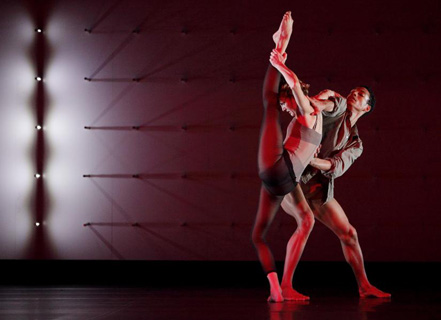 The Guardian, November 19 2010
The Guardian, November 19 2010“There is material of heart-stopping beauty as well as of rugged difficulty… the stage seems like an exhibition of all variations of human behaviour, as seen through the ideas of Descartes, Rousseau and De Sade. As pure dance, it is some of McGregor's finest invention… a counterpoint of ineffable delicacy like no dance I've ever imagined or seen”
Ever since the ballet world claimed Wayne McGregor as its hottest new choreographer, it has been tempting to see him as a dance-maker of two halves. There's the McGregor who shapes sharply finessed and mysteriously affecting ballets for classical companies. Then there's the McGregor who creates for his own group, Random, and for whom every new work appears to be intense inward wrestling with movement and ideas.
In his latest piece, Far, both aspects are in evidence. There is material of heart-stopping beauty as well as of rugged difficulty. But while the choreography is remarkable and the dancers superb, the work struggles to become more than the sum of its parts.
McGregor's starting point is the Age of Enlightenment, the moment when science and philosophy began to question traditional concepts of the divine soul and the unruly animal body. Far opens with music by Verdi, and a man and woman touching and embracing in ways that combine the blunt nuzzling ease of animals and the questioning intelligence of humans.
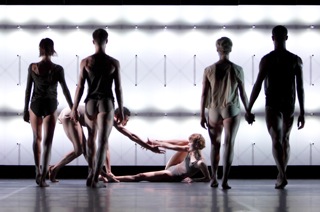 Abruptly, the music shifts
into Ben Frost's electronic sound score, and a white screen becomes animated
with radiant, flickering light. It is as if we've entered a dance laboratory:
the choreography investigates a range of movement – steely and linear, clotted
and dysfunctional – and contrasts classical configurations with duets of
sometimes violent sexual attack. With Frost's score blending guttural animal
noises into its ambient sounds and the screen radiating its own pure, cerebral
beauty, the stage seems like an exhibition of all variations of human behaviour,
as seen through the ideas of Descartes, Rousseau and De Sade. As pure dance,
it is some of McGregor's finest invention: one section where two women fold
into origami geometries while three others drift through a counterpoint
of ineffable delicacy is like no dance I've ever imagined or seen.
Abruptly, the music shifts
into Ben Frost's electronic sound score, and a white screen becomes animated
with radiant, flickering light. It is as if we've entered a dance laboratory:
the choreography investigates a range of movement – steely and linear, clotted
and dysfunctional – and contrasts classical configurations with duets of
sometimes violent sexual attack. With Frost's score blending guttural animal
noises into its ambient sounds and the screen radiating its own pure, cerebral
beauty, the stage seems like an exhibition of all variations of human behaviour,
as seen through the ideas of Descartes, Rousseau and De Sade. As pure dance,
it is some of McGregor's finest invention: one section where two women fold
into origami geometries while three others drift through a counterpoint
of ineffable delicacy is like no dance I've ever imagined or seen.Yet this often exhilarating, dazzling piece is undermined by two things. The first is Frost's score, which goes from the serviceably atmospheric to the downright obtrusive in those sections where it features singer Helgi Hrafn Jónsson. Jónsson's breathy faux-Björk style introduces a coy, self-conscious tone that the work can't accommodate. The second is a slackening of focus and tension in McGregor's own choreography during the final third. Far may end on a beautiful image, with a woman's body being laid out reverentially on the floor as the lighted screen slowly ascends. Yet you're still left with the feeling that it has punched below its own theatrical and intellectual weight.
 London Evening Standard, November 18 2010
London Evening Standard, November 18 2010"[P]hysical attraction is recycled into an elliptical, fractured, collapsing series of anemone arms and insect legs, with contortions and tensions that never meet let alone resolve. There are also choreographic non-sequiturs and physical blind alleys, and an ocean-going disregard for theatre’s conventional build, crescendo and coda."
Contemporary choreographers rarely make the crossover to mainstream audiences. One exception is Wayne McGregor who did just that when he created Chroma for The Royal Ballet in 2006.
Chroma’s visual allure, and ingenious yet accessible choreography, had widespread appeal, especially when you factor in Joby Talbot’s glossy music which featured orchestrations of White Stripes tunes. An indication of Chroma’s popularity is that the Bolshoi Ballet, San Francisco Ballet and Canadian National Ballet are all keen to dance it.
For his own troupe, Random Dance, McGregor choreographs in more challenging vein. Indeed, his new 70-minute FAR may test even hardcore fans. McGregor’s innovation is to use extreme beauty only without aiming to please. His dancers are gorgeous yet they take no privileges, let alone dispense any. Their physical attraction is recycled into an elliptical, fractured, collapsing series of anemone arms and insect legs, with contortions and tensions that never meet let alone resolve. There are also choreographic non-sequiturs and physical blind alleys, and an ocean-going disregard for theatre’s conventional build, crescendo and coda.
McGregor cleverly links these choreographic means to themes in Roy Porter’s posthumous book Flesh In The Age Of Reason on which FAR draws and after which it is named. McGregor examines the idea of the body being the "inseparable dancing partner of the mind", with his moves looking how we think — randomly, unevenly and in a "tangle of limbs and intentions".
There are 10 dancers who, as I say, are gorgeous, as is rAndom International’s set design. Ben Frost’s music is unforgiving, and the theatrical flourish of four torch bearers feels superfluous and out of sync. However, McGregor’s reputation is secure.
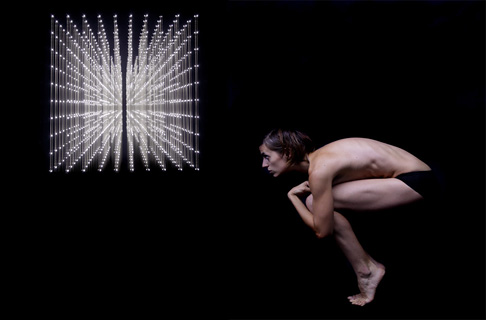 Daily Express, November 19 2010
Daily Express, November 19 2010"FAR_one of [McGregor's] most successful and satisfying works since Chroma."
A NEW work by dance wunderkind Wayne McGregor is always an event but the fact that anticipation runs high can sometimes erode appreciation of the work.
Fortunately, FAR is one his most successful and satisfying works since Chroma.
Inspired by Roy Porter’s Flesh In The Age of Reason, a study of 18th-century scientific enquiries on the relationship between body and soul, FAR is initially accessible even if its meaning becomes increasingly obtuse.
The stage is dominated by Lucy Carter’s huge rectangular light board which moves through several configurations. At one time, rows of white lights undulate across the surface; at another a single star-like bulb illuminates the dancers. It is like watching the synapses of a brain snapping and popping with electrical impulses.
As if triggered by the lighting, dancers move and shift in solos and groups of twos and threes, flexing in the contortions and sky-reaching stretches that typify McGregor’s movement vocabulary.
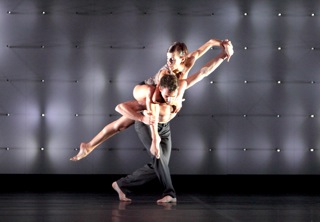 Apart from a disturbing sequence in which two dancers appear to be trying
to dislocate their rib cages, he has moderated the grotesque extremes of
his movement for the most part and here the sinuous duets and clinically
eroticised trios possess a strange, alien beauty.
Apart from a disturbing sequence in which two dancers appear to be trying
to dislocate their rib cages, he has moderated the grotesque extremes of
his movement for the most part and here the sinuous duets and clinically
eroticised trios possess a strange, alien beauty.There are times when he resorts to the natural world, introducing into his structures the proud swagger of great apes and the strutting condescension of birds. Better still, there is a clear sense of evolution and dialogue between the figures on stage; the sense of history unfolding and the passage of time is suggested by the initial torch bearers and later a digital clock. There is even, dare I say it, a riptide of poignancy that seeds feelings of love, hate, despair, sadness and occasional joy that geminate throughout.